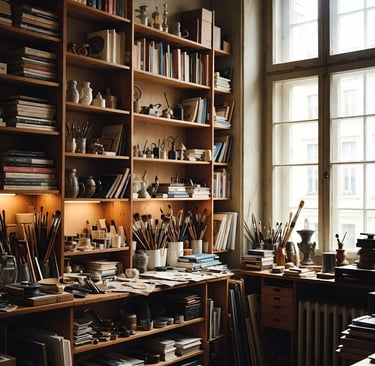Feed Your Creative Soul! The Art Library: Your Personal Studio, Museum, and Teacher
Hello, artists, dreamers, and lovers of beauty that defies form. If you have a brush, a pencil, or a pixel in your hand, you know that creation is an act of giving, but also, and fundamentally, an act of receiving. Receiving inspiration, receiving knowledge, and above all, receiving the legacy of those who came before. Where does this treasure reside? Not only on the walls of museums, but on the pages of a book: your own art library. #ArtEducation #ArtResearch 📚 More Than Ink and Paper: The Value of Your Collection Building an art library isn't just filling shelves; it's building your creative foundation and your personal sanctuary of inspiration. This body of knowledge is crucial for any artist seeking longevity and depth, qualities highly valued in #CuratorialPractice. Your Silent Mentor: An art book places you face-to-face with masterpieces and the processes of the greats, without the rush of a museum visit. You can analyze Van Gogh's brushwork, unravel Da Vinci's composition, or meditate on Itten's color theory, all at your own pace. The Idea Engine: Creative block? Open a book at random. The colors, textures, and patterns of an unknown artist can be the spark that ignites your next work. It is a bottomless well of visual solutions, essential for #ArtHistoricalContext. History and Context: To innovate, you first have to understand tradition. Knowing art history gives you the necessary context so that your work is not just a copy, but a conversation with the past. ✨ Dive Into the Love of Art (and Dare to Go Abstract) While it's vital to know figurative and classical art, I invite you to take a step further in your immersion and embrace Abstract Art with all your heart. Galleries and curators are always looking for artists who can articulate the why behind their work, and abstraction teaches this discipline. #ContemporaryArt Many people view abstraction as "easy" or "meaningless," but it's quite the opposite. Abstract art is the purest and bravest form of expression, and diving into it will teach you to: Love Pure Visual Language: Abstract art removes the "crutch" of recognizable reality (a tree, a person) and forces us to work only with essential elements: color, line, shape, and texture. It’s high-level training for your eye and a focus for #ElementsOfArt. Trust Intuition: Artists like Kandinsky, Rothko, or Pollock weren't trying to draw an object; they sought to capture an emotion, a rhythm, or a spiritual idea. Studying their processes will encourage you to let go of control and trust what your hand wants to do, not just what your mind commands. Break Your Own Rules: Abstract art shows you that freedom is not chaos, but the discipline of emotion. By understanding how Malevich reduced everything to a black square, or how De Kooning used gesture, you gain the intellectual and emotional permission to shatter your own creative limits. This Emotional Discipline is what makes #EmergingArtists stand out. 🔑 Start Today! You don't need to buy 50 books all at once. Start with three essential pillars: A Classic: A good book on Art History. A Technical Guide: A manual on composition, color theory, or drawing. Your Passion: A monograph on an artist (or movement!) you're obsessed with. If it's abstract, even better: look for texts on Abstract Expressionism, Minimalism, or Suprematism. These are the movements that define much of #GalleryLife and hold significant value for #ArtInvestment. Every book is a seed of inspiration. Every page read is one more color on your mental palette. Make your art library your refuge, your private museum, and the inexhaustible source of that sacred fire that drives you to create. Dive in! Art is infinite, and so is your potential.
Eduardo Lucas - Artista - Mentor
11/14/20251 min read


Contenido de mi publicación
Solicitud de información
© 2025. All rights reserved.